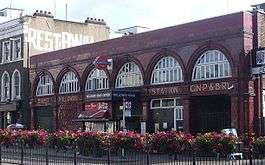Holloway Road tube station
Holloway Road is a station on the London Underground. It is on the Piccadilly line between Caledonian Road and Arsenal stations, and in Travelcard Zone 2. The station opened on 15 December 1906.
| Holloway Road | |
|---|---|
 | |
 Holloway Road Location of Holloway Road in Greater London | |
| Location | Holloway |
| Local authority | Islington |
| Managed by | London Underground |
| Number of platforms | 2 |
| Fare zone | 2 |
| London Underground annual entry and exit | |
| 2014 | |
| 2015 | |
| 2016 | |
| 2017 | |
| 2018 | |
| Key dates | |
| 15 December 1906 | Opened |
| Listed status | |
| Listing grade | II |
| Entry number | 1195635[3] |
| Added to list | 17 May 1994 |
| Other information | |
| External links | |
| WGS84 | 51.55306°N 0.11194°W |
The station was constructed by the Great Northern, Piccadilly and Brompton Railway and was built with two lift shafts, but only one was ever used for lifts. The second shaft was the site of an experimental spiral escalator which was built by the American inventor of escalators, Jesse W. Reno. The experiment was not successful and was never used by the public. In the 1990s, remains of the escalator equipment were excavated from the base of the lift shaft and stored at the London Transport Museum Depot in Acton. From the platforms, a second exit no longer in use is visible and leads to the back of the used lift shaft.
The station is adjacent to the site of the former Holloway and Caledonian Road railway station.
The station is close to the new Emirates Stadium, the new home of Arsenal football club. As part of the planning permission £5m was due to be spent expanding the current station to cope with increased passenger numbers on match days. However subsequent studies showed that to ensure the station could cope with the numbers the lifts would have to be replaced with escalators which would cost £60m. As a result, the redevelopment plans were put on hold and now at match times the station is exit only, and before a match eastbound trains do not call.[4]
Design
The architect was Leslie Green who built it for the Great Northern, Piccadilly and Brompton Railway (Now part of London Transport). The building is listed by English Heritage as Grade II.[3]
Refurbishment, 2007–2008
Refurbishment works completed in 2008 included the installation of a new public address system, replacement of aging customer information screens, and other aesthetic changes to improve the look, feel and security of the station. This includes improved lighting and a dramatic increase in the number of CCTV cameras.
Connections
London Buses routes 43, 153, 263, 271 and 393 and night bus route N41 serve the station.
References
- "Multi-year station entry-and-exit figures (2007-2017)" (XLSX). London Underground station passenger usage data. Transport for London. January 2018. Retrieved 22 July 2018.
- "Station Usage Data" (CSV). Usage Statistics for London Stations, 2018. Transport for London. 21 August 2019. Retrieved 27 April 2020.
- Historic England. "Holloway Road Station (London Transport) (1195635)". National Heritage List for England. Retrieved 3 April 2015.
- "Get to... Emirates Stadium – Matchday arrangements". www.arsenal.com. Arsenal Broadband Limited. 2011. Archived from the original on 12 August 2008.
Gallery
.jpg) The Art Nouveau styled ironwork designed by Leslie Green at Holloway Road station
The Art Nouveau styled ironwork designed by Leslie Green at Holloway Road station- Eastbound platform looking south towards central London
- Westbound platform looking north towards Cockfosters
- Roundel on the eastbound platform
- Tiling on the eastbound platform
- Maker's tile on the westbound platform
External links
| Wikimedia Commons has media related to Holloway Road tube station. |
- "Photographic Archive". London Transport Museum. Archived from the original on 18 March 2008.
- "Pictures of the disused staircase". Abandoned Stations. Archived from the original on 7 February 2006.
- "Photographs of Holloway Road station". TubePhotos. Archived from the original on 3 October 2011.
| Preceding station | Following station | |||
|---|---|---|---|---|
| Piccadilly line | towards Cockfosters |